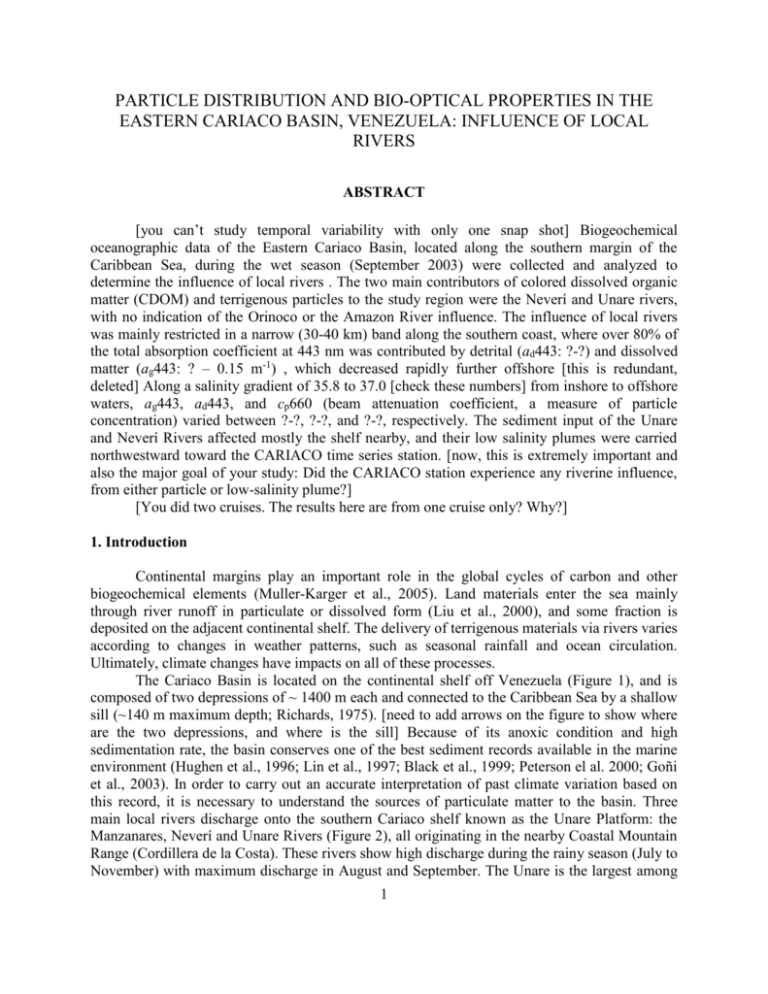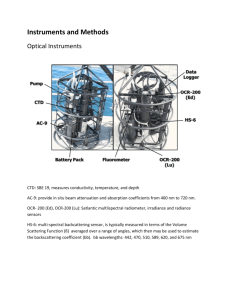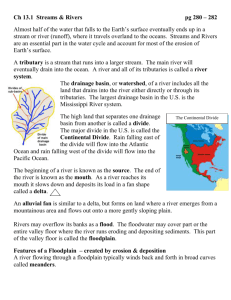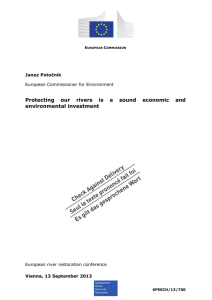3.1 River influence on the optical properties of Cariaco`s coastal
advertisement

PARTICLE DISTRIBUTION AND BIO-OPTICAL PROPERTIES IN THE EASTERN CARIACO BASIN, VENEZUELA: INFLUENCE OF LOCAL RIVERS ABSTRACT [you can’t study temporal variability with only one snap shot] Biogeochemical oceanographic data of the Eastern Cariaco Basin, located along the southern margin of the Caribbean Sea, during the wet season (September 2003) were collected and analyzed to determine the influence of local rivers . The two main contributors of colored dissolved organic matter (CDOM) and terrigenous particles to the study region were the Neverí and Unare rivers, with no indication of the Orinoco or the Amazon River influence. The influence of local rivers was mainly restricted in a narrow (30-40 km) band along the southern coast, where over 80% of the total absorption coefficient at 443 nm was contributed by detrital (ad443: ?-?) and dissolved matter (ag443: ? – 0.15 m-1) , which decreased rapidly further offshore [this is redundant, deleted] Along a salinity gradient of 35.8 to 37.0 [check these numbers] from inshore to offshore waters, ag443, ad443, and cp660 (beam attenuation coefficient, a measure of particle concentration) varied between ?-?, ?-?, and ?-?, respectively. The sediment input of the Unare and Neverí Rivers affected mostly the shelf nearby, and their low salinity plumes were carried northwestward toward the CARIACO time series station. [now, this is extremely important and also the major goal of your study: Did the CARIACO station experience any riverine influence, from either particle or low-salinity plume?] [You did two cruises. The results here are from one cruise only? Why?] 1. Introduction Continental margins play an important role in the global cycles of carbon and other biogeochemical elements (Muller-Karger et al., 2005). Land materials enter the sea mainly through river runoff in particulate or dissolved form (Liu et al., 2000), and some fraction is deposited on the adjacent continental shelf. The delivery of terrigenous materials via rivers varies according to changes in weather patterns, such as seasonal rainfall and ocean circulation. Ultimately, climate changes have impacts on all of these processes. The Cariaco Basin is located on the continental shelf off Venezuela (Figure 1), and is composed of two depressions of ~ 1400 m each and connected to the Caribbean Sea by a shallow sill (~140 m maximum depth; Richards, 1975). [need to add arrows on the figure to show where are the two depressions, and where is the sill] Because of its anoxic condition and high sedimentation rate, the basin conserves one of the best sediment records available in the marine environment (Hughen et al., 1996; Lin et al., 1997; Black et al., 1999; Peterson el al. 2000; Goñi et al., 2003). In order to carry out an accurate interpretation of past climate variation based on this record, it is necessary to understand the sources of particulate matter to the basin. Three main local rivers discharge onto the southern Cariaco shelf known as the Unare Platform: the Manzanares, Neverí and Unare Rivers (Figure 2), all originating in the nearby Coastal Mountain Range (Cordillera de la Costa). These rivers show high discharge during the rainy season (July to November) with maximum discharge in August and September. The Unare is the largest among 1 these rivers, with a drainage basin area of 22.3 Km2 and an approximate average discharge rate of 56 m3/sec (Zinck, 1977). The Neverí and Manzanares are smaller (drainage basin of 3.9 and 1.0 km2, respectively), discharging approximately 35 and 22 m3/sec, respectively, into the Cariaco Basin (Zinck, 1977). These discharge rates were measured during 1958-1967. Unfortunately, data are not available to assess more recent discharges. Several of the rivers have since been dammed, while others now receive contributions from sewer systems, industry and urban areas. [this is redundant] The CARIACO (Carbon Retention in a Colored Ocean) oceanographic time series project has collected over 9 years of data, including sediment traps, optics and hydrography in the Cariaco Basin (Muller-Karger et al., 2005) at lat lon (Figs. 1 and 2). The lowest surface salinities and highest terrigenous inputs at the time series station occur in September (Astor et al., 1998). There has been a lingering question as to whether these changes are associated with local rivers or the larger Orinoco plume that enters the Caribbean Sea (see Muller-Karger et al., 1989). In the framework of the CARIACO project, we conducted extensive cruises in the rainy and dry seasons (September 2003 and March 2004, respectively) to help understand river runoff into the Cariaco Basin and whether small, local rivers are more influential than larger, more distant rivers, such as the Orinoco. 2. Methods 2.1. Data collection Two cruises were conducted to the Cariaco Basin between September 16-20 2003 and March 15-20, 2004, using the R/V Hermano Gines of the Fundacion La Salle de Ciencias Naturales de Venezuela (FLASA/EDIMAR). In September 2003, 39 stations were sampled, with 19 in shallow waters (<200 m) and the other 20 in a grid-like pattern (Fig. 2). Similar sampling scheme was used for the March 2004 cruise. At each station, salinity and temperature profiles were measured using a Seabird SBE25 CTD. Oxygen data and chlorophyll fluorescence were obtained with a Seabird SBE 43 oxygen sensor and a Chelsea fluorometer (Chelsea, Inc.), respectively, attached to the CTD. The ensemble also had a C-Star transmissometer (WetLabs) that measured beam attenuation coefficient at 660 nm (cp(660), m-1). One absorption/attenuation meter (AC-9, WetLabs) was deployed as part of the hydrocasts during September 2003. A pump was used to draw water through the absorption and attenuation tubes. At 14 stations, double casts were performed, one with an unfiltered AC-9, and the second using a 0.2 m filter (Propor PES filter capsules) attached to the inlet of the absorption tube. The instrument was calibrated before, during, and after the cruise using distilled water as a reference. Water samples from some selected stations and depths were filtered with a 0.2 m poresize anotop filter to determine the absorption coefficients of CDOM. 2.2. Data processing 2 AC-9 data were corrected for temperature and salinity effects, following Pegau et al. (1997). A scattering correction was also applied to the absorption data by subtracting a reference value at 715 nm from all data at other wavelenths (hypothesis 3 in the AC-9 WetLabs User’s Guide, 2003). The good agreement between AC-9 beam attenuation coefficient at 650 nm (cp(650)) and C-Star transmissometer data (cp(660)) (r =?, N=?, slope=?, intercept =?) suggested high data quality. [You didn’t mention the C-Star transmissometer in the data collection section] The spectral shape () of the beam attenuation coefficient, as an measure of particle size distribution (Diehl and Haardt, 1980) was calculated as follows (Boss and Zeneveld, 2003): cp() = cp(o)*(o)- CDOM Absorbance (A) spectra were measured between 200 and 800 nm with a dual fiber optic spectrometer (Ocean Optics) equipped with 10-cm quartz cuvettes. The detection limit of the spectrophotometer was ± 0.002, equivalent to absorption coefficients of 0.046 m-1. [note that in Fig. 5 many values are below this limit – do you still trust the S data?] Distilled water was used as a blank. CDOM absorption coefficients were calculated as: ag() = ln 10 A()/r (2) where “r” is the pathlength (0.1 m). ag() has been reported to decrease exponentially with increasing wavelength as: ag() = ag(o)exp[–S(o)] (3) where is a reference wavelength and S (nm-1) is the spectral slope (Blough et al, 1993; Green and Blough, 1994; Ferrari, 2000, Blough and Del Vecchio, 2002). A non-linear least square fit method was used to estimate S. Absorption coefficients of phytoplankton pigments (aph) were not measured directly, but rather derived from in situ fluorometric measurements, using relationships obtained by the CARIACO project (199? – 200?). aph for the CARIACO dataset was measured in situ through filtration following Kishino et al. (1985). The factor from Mitchell and Kiefer (1988) was used for the correction of the optical path elongation due to filter pads. The relationship between aph at 440 nm and chlorophyll fluorescence was obtained from the CARIACO time-series data:: aph(440) = 0.0955 * FChl + 0.0101 (r2 = 0.93, n=? RMS=?) Using the equation above and fluorometric data from the September 2003 cruise, aph(440) was obtained. [Now – how do you know if FChl from CARIACO and FChl from sept 2003 were measured consistently? Also, in the data collection section you didn’t mention anything about chlorophyll fluorescence measurement] 3 4 Table 1: Station location, cast and bottom depth, SSS, SST and mixed layer depth for the September 16-20, 2003 cruise. Latitude Longitude Station 10.83 10.66 10.50 10.33 10.49 10.66 10.83 10.83 10.66 10.49 10.33 10.33 10.23 10.14 10.19 10.28 10.49 10.66 10.83 10.66 10.49 10.41 10.33 10.23 10.23 10.33 10.41 10.33 10.41 10.49 10.83 11.00 11.00 11.00 10.99 10.44 10.14 10.16 10.41 -64.37 -64.36 -64.36 -64.55 -64.55 -64.55 -64.55 -64.70 -64.71 -64.66 -64.71 -64.88 -64.88 -65.03 -64.79 -64.8 -64.88 -64.88 -64.88 -65.05 -65.05 -65.05 -65.05 -65.05 -65.21 -65.21 -65.21 -65.38 -65.38 -65.21 -65.04 -65.04 -64.88 -64.71 -64.54 -64.26 -65.11 -65.21 -64.40 0 1 2 3 4 5 6 7 8 9 10 11 12 13 14 15 16 17 18 19 20 21 22 23 24 25 26 27 28 29 30 31 32 33 34 48 49 50 51 Maximum profiling depth (m) 225 157 400 120 400 400 220 225 400 400 40 56 37 15 26 45 400 400 224 400 400 63 59 25 24 56 75 55 77 113 220 80 130 174 273 70 15 10 180 Bottom depth (m) 235 167 1058 128 1328 422 230 237 520 1220 51 66 47 19 36 55 1100 815 234 875 547 73 69 35 34 66 84 65 87 178 229 150 135 184 283 95 15 12 190 *Und. = Unable to determine [this table should be put in a separate file] 5 Sea Surface Salinity 36.79 36.76 36.74 36.56 36.73 36.76 36.76 36.71 36.73 36.56 36.58 36.58 36.55 36.63 36.01 36.55 36.61 36.60 36.66 36.64 36.63 36.67 36.63 36.54 36.59 36.64 36.65 36.62 36.66 36.66 36.65 36.69 36.68 36.70 36.86 36.76 35.30 36.07 36.62 Sea Surface Temperature (°C) 28.49 28.26 27.90 28.01 28.14 28.34 28.50 28.20 28.18 28.35 27.73 27.96 27.73 28.11 27.58 27.68 27.66 27.66 27.84 27.68 27.61 27.41 27.86 28.45 27.62 27.39 27.32 27.66 27.31 27.42 27.73 27.63 27.70 27.96 28.33 28.03 27.64 27.98 28.15 Mixed layer depth (m) 15 14 14 9 17 21 23 21 18 10 11 12 12 7 6 10 18 23 28 29 20 20 7 8 8 14 24 12 20 20 17 19 21 27 22 12 7 Und. 9 3. Results [Without mentioning salinity, how do you know they are river plumes, not upwelled bottom CDOM?] Highest ag(440) values were found during September 2003 at Stations 14 (0.134 m-1) and 13 (0.148 m-1) (See Figure 2 for reference), accompanied by low salinity (? How much? Fig.6 shows station 49 instead of 13 has the lowest salinity, why?]. Also, the CDOM absorption spectral slope, S (nm-1), was lower at these stations (give range here) than at other offshore stations (give range here). Clearly, these high-CDOM low-salinity waters are characteristics of river plumes. Indeed, these stations are located near the river mouths of the Neverí and Unare. There was no low salinity or high CDOM signal to the north of the Basin (Figure 6) [where? Give a latitude threshold or water depth threshold]. ag(440) was relatively low (~0.04 m-1) and the water was blue at Station 48 (Figure 3), close to the ManzanaresRive. However, traces of leaves, plastic and other types of debris were seen at this site. [Now, do you see any influence on the CARIACO location? This should be the most important thing in the paper] At stations near the coast (22, 21 and 11, See Fig. 2), total absorption coefficients (water excluded) at depths of 1, 5, 10, and 25 m (Figure 4) [if this figure is mentioned in the text later than Fig. 6, the order should be rearranged] showed small absorption peaks at 676 nm, indicating the presence of phytoplankton. However, the typical absorption shape of phytoplankton in the blue part of the spectrum was masked by CDOM, where ag443 contributed to >70% of the total absorption coefficient at 443 nm. Further [this is irrelevant to your objective] Station 21 showed some of the strongest absorption at 10 and 25 m, which corresponded to higher chlorophyll concentrations. [so what?] [I think Fig. 4a is enough to say what you want to say, because the rest doesn’t show big differences. The more concise the better]. [Fig. 5 is not necessary] Figure 6 shows the distribution of sea surface salinity, temperature, and cp(660) (m-1) in the Eastern Cariaco Basin for September 2003 and March 2004. During the September 2003 cruise, the Unare River plume, as indicated by the low salinity (~35.4), was associated with high cp(660) values (~ 1 m-1). Further offshore, cp(660) decreased while salinity decreased, suggesting dispassion and/or sinking of suspended particles. Most particles associated with the rivers precipitated from surface waters within 10 km from their mouths. [I don’t understand this. At least up to 10.3 degree N you can still see the particle signature and this is at least 20 km away from the river mouth] During September 2003, waters in the Basin were stratified and the average mixed layer depth near the coast was 8.5 m. In the deeper parts of the basin (> 100 m), the average mixed layer depth was approximately 18.6 m. (Table I). The stratified waters near the coast enabled the river plumes to be also visible in the sea surface temperature contour of the Basin (Figure 6). The Unare River was characterized by a plume of warmer water (~28.7°C), possibly due to the strong light absorption and thin fresher water lens.The Neverí and Manzanares river plumes were of colder water (~27.6°C and ~28°C, respectively) [colder? These may be the background SST for that region]. 6 During March 2004, cp(660) in the entire study area, especially in the coastal waters, was higher, compared to September 2003, due to the enhanced primary productivity stimulated by the seasonal upwelling [ref?]. The cold, salty, nutrient rich upwelled water was visible also in the sea surface temperature and salinity data (Figure 6). Figure 7 shows the distribution of cp(660) at the maximum sampling depth of each station in September 2003 (see Table 1 for reference). High attenuation was observed throughout the Unare Platform [where is this platform?], with higher values (~0.6 - 1 m-1) near the bottom of stations 49 and 13 (close to the Unare River mouth). [to exclude the possibility that these are due to phytoplankton bloom – what are the chl values at these two stations at the same bottom depths?] This higher beam attenuation near the bottom was interpreted as bottom nepheloid layers (BNL) (Pak et al., 1984; Boss et al., 2001; Xu et al., 2002; McPhee-Shaw et al., in press). These BNL’s extended through station 12, to the east of the Unare River’s mouth (0.5-0.6 m-1). Just like the Unare’s BNL, the Neveri’s was skewed to the right, towards the east, and it was less attenuating than the Unare (0.55-0.6 m-1). The thickness of the BNL’s varied. Near the Neverí River, the BNL ranged from 6 to 15 m, while near the Unare it was <5m. Suspended, or intermediate nepheloid layers (INL’s), were seen at stations 15 and 11 at depths of 35 and 45 m, respectively. [do these extend to the CARIACO station?] Intermediate nepheloid layers were also observed in September 2003 near the Manzanares River at station 2 (10o29’N 64o21’W), located over a submarine canyon (~0.09 m-1). [I don’t see this from Fig. 7] During March 2004, INL’s were also observed at the same location, though thinner and more attenuating (~ 0.15 m-1). [all sentences before this point are perhaps not necessary] Figure 8 compares some sample profiles at Station 2 (10o29’N 64o21’W) [I told you to be consistent in lat lon – in the graphs you used decimal degrees], where the INL’s were observed in both September 2003 and March 2004. During September 2003, the INL was located at ~220 m depth and had an approximate thickness of 50 m. (upper right box in figure 8). The INL’s did not show a corresponding variation in absorption, nor were associated with the strong pycnocline of the Cariaco Basin. The maxima observed in the beam attenuation profile of station 9 (bottom right box in figure 8) are all associated with either a maximum of fluorescence or the Cariaco Basin’s pycnocline. During March 2004, the INL’s were located at a shallower depth than in September 2003 (~ 70 m and 180 m; upper right box in Figure 8). Once more, these layers were not associated with any density changes or phytoplankton maxima. During March 2004, waters in the Basin were well mixed, and typical beam attenuation profiles were similar to that of station 9, depicted in the lower right box in Figure 8: high attenuation at the surface, due to the increased productivity, but low attenuation below 50 m (below the pycnocline). [I feel dizzy when reading this paragraph – what do you want to say?] For September 2003, was calculated for the INL’s. is related to particle size distribution, and as particles become larger, decreases according mainly to the size of the particles (Boss et al., 2001). at the INL’s decreased, indicating the INL’s were probably composed of larger particles than their surroundings, perhaps aggregates. [is this important? Delete if not] [you don’t need to cite others only to prove your values make sense] 4. Discussion 7 The two main contributors of CDOM, fresh water, and particles to the eastern Cariaco Basin during September 2003 were the Neverí and Unare rivers. Their signatures were reflected in all parameters measured, including salinity, CDOM absorption coefficient, and beam attenuation coefficient (a measure of particle concentration). In contrast, the plume of the Manzanares River was less apparent, and no evidence was observed to show the intrusion from the much larger rivers (Orinoco and Amazon Rivers) from the east. [In “discussion,” you don’t need to summarize what you found (that should be in the conclusion). Rather, you need to discuss the implications or importance of your findings, and perhaps argue with yourself why these results are important] [if this is already documented, what is the purpose of this paper?] Thunell et al. (2000), Goni et al. (2003) and Goñi et al. (2004) have reported terrigenous material in sediment traps located near the CARIACO times-series station [give lat lon], likely from local rivers. However, sediments discharged by the local rivers in September 2003 did not reach that far. The material observed in the traps was probably transported at intermediate depths, in layers breaking off the bottom of the shelf [what does this mean]. These layers at intermediate depths (150-300 m) could constitute an important pathway of coastal sediment transport to the central Cariaco Basin. Such layers were observed at 10o29’N 64o21’W over a submarine canyon during both the September 2003 and March 2004 surveys. Hickey et al. (1986) determined that the dominant mode of sediment transport off the shelf in Quinault Canyon was by episodic formation of turbidity layers at intermediate depths caused by horizontal advection. Puig et al. (2003) also observed such a persistent layer, which contributed to the off-shelf sediment transport in Eel Canyon. Puig and Palanques (1998) suggested that in canyons located on continental margins, such as the Foix Canyon, sediment transport could be dominated by intermediate nepheloid layer detachments and internal waves. [these are pure speculations] [you have nothing to support this] [this appears very abrupt] [Now, my question is, is the year of 2003 a “typical” year? i.e., can the wet season of 2003 represent a “typical” case? To answer this you need to examine rainfall data. Without answering this it is hard to draw any conclusions] 5. Conclusions During the wet season (September 2003), the local rivers that most significantly affected the bio-optical properties and particle distributions in the Eastern Cariaco Basin are the Neverí and Unare rivers. No evidence of larger South American river (e.g., Amazon or Orinoco) intrusion was observed in September 2003 or March 2004. The influence of local rivers was mainly restricted within a narrow (30-40 km) band along the southern coast of the Cariaco Basin, where all bio-optical parameters showed some anomaly. Salinity was between ?-? versus ? in offshore waters; beam attenuation coefficient at 660 nm (cp660, a measure of particle concentration) was between ?-? versus ? in offshore waters; CDOM absorption coefficient at 440 nm (ag(440), m-1) contributed to 70% of the total absorption coefficient at 440 nm and the spectral slope is lower [give range] than that from offshore [give range]. During September 2003, the Unare River discharged more suspended particulate matter than did the Neverí River. cp660 decreased rapidly from 0.6 m-1 at a station 10 km from the river mouth to 0.4 m-1 10 km further offshore, indicating particle sinking to the bottom Indeed, the 8 bottom nepheloid layers, visible throughout the Unare Platform [where is this platform?], were strongest near river mouths. The radius of the influence of the Unare’s BNL was approximately 40 [check this number] km from the mouth of the river, while the Neverí’s was close to 23 km. The coast waters off the Manzanares River did not show any anomaly in the surface salinity, CDOM, or suspended matter. However, internal [internal?] nepheloid layers were observed near the Manzanares River, over a submarine canyon, both in September 2003 and March 2004. This may be an important mechanism of sediment transport off the shelves and into the Eastern Deep [what is this eastern deep?]. [this is nearly nonsense. Any river can discharge materials into adjacent ocean – you don’t need to conduct two cruises to prove this. You also said in the conclusion of their influence, so no need to repeat in a qualitative tone here]. [this is also nearly nonsense] Clearly, the eastern Caribbean basin is under influence of local rivers. Although their surface signatures in salinity and CDOM are restricted to…, the bottom nepheloid layers can extend further offshore, up to 50 km from the coast. The CARIACO time-series station, where monthly biogeochemical data have been collected since 1996, was (or was not) under the influence of these local rivers. [if yes, so what?] [if no, may add the following: However, the data were collected from two cruises only. More oceanographic surveys are needed to further understand the connections between local rivers and the CARIACO station]. 9







